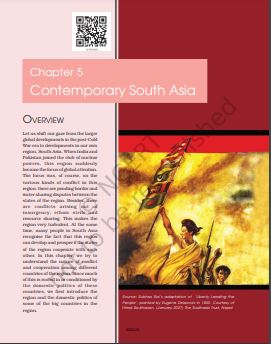‘NCERT Solutions for Class 12 Political Science Chapter 5‘ PDF Quick download link is given at the bottom of this article. You can see the PDF demo, size of the PDF, page numbers, and direct download Free PDF of ‘Ncert Class 12 Political Science Chapter 5 Exercise Solution’ using the download button.
NCERT Class 12 Political Science Textbook Chapter 5 With Answer PDF Free Download

Chapter 5: Contemporary South Asia
We are all familiar with the gripping tension during an India-Pakistan cricket match. We have
also seen the goodwill and the hospitality shown to visiting Indian and Pakistani fans by their
hosts when they come to watch a cricket match.
This is symbolic of the larger pattern of South Asian affairs. Ours is a region where rivalry and goodwill, hope and despair, mutual suspicion and trust coexist.
The expression ‘South Asia’ usually includes the following countries: Bangladesh, Bhutan,
India, the Maldives, Nepal, Pakistan, and Sri Lanka.
The mighty Himalayas in the north and the vast Indian Ocean, the Arabian Sea, and the Bay of Bengal in the south, west, and east respectively provide a natural insularity to the region, which is largely responsible for the linguistic, social, and cultural distinctiveness of the subcontinent.
The boundaries of the region are not as clear in the east and the west, as they are in the
north and the south.
Afghanistan and Myanmar are often included in discussions of the region as a whole.
China is an important player but is not considered to be a part of the region. In this chapter, we
shall use South Asia to mean the seven countries mentioned above.
Thus defined, South Asia stands for diversity in every sense and yet constitutes one geopolitical space.
The various countries in South Asia do not have the same kind of political systems.
Despite many problems and limitations, Sri Lanka and India have successfully operated a democratic system since their independence from the British.
You will study more about the evolution of democracy in India in the textbook, which deals with politics in India since independence.
It is, of course, possible to point out many limitations of India’s democracy; but we have to remember the fact that India has remained a democracy throughout its existence as an independent country. The same is true of Sri Lanka.
Pakistan and Bangladesh have experienced both civilian and military rulers, with Bangladesh remaining a democracy in the post-Cold War period.
Pakistan began the post-cold War period with successive democratic governments under Benazir Bhutto and Nawaz Sharif respectively. But it suffered a military coup in 1999.
| Author | NCERT |
| Language | English |
| No. of Pages | 16 |
| PDF Size | 2.9 MB |
| Category | Political Science |
| Source/Credits | ncert.nic.in |
NCERT Solutions Class 12 Political Science Chapter 5 Contemporary South Asia
1. Despite the mixed record of democratic experience, the people of all the countries of South Asia share the aspiration of democracy.
Answer: The various countries in South Asia have experienced a mixed record of democracies and the people also share an aspiration for democracy to be flourished not only in rich or developed countries but in developing and underdeveloped countries also which can be drawn from the examples of Nepal, Pakistan, Bangladesh, Bhutan, and the Maldives, because:
1. Every ordinary citizen, rich or poor and belonging to different religions views the idea of democracy positively and supports the institutions of representative democracy.
2. They prefer democracy over any other form of democracy and think that democracy is suitable for their country.
2. Describe any two major issues of conflicts between India and Pakistan leading to the war of 1971.
Answer: The 1947-48 war resulted in the division of the province into Pakistan-occupied Kashmir (Pok) and the Indian province of Jammu and Kashmir divided by the Line of Control (LOC).
Pakistan claims Kashmir to be its part but India presumes it to be its integral part. Hence, these conflicts led to war in 1971, and India won but the issues remain unsettled.
3. Describe any four consequences of the Bangladesh war of 1971.
Ans: 1. India supported the demand of East Pakistan financially and militarily.
2. The war of 1971 made Pakistani forces surrender in East Pakistan.
3. Bangladesh was formed as an independent country.
4. Bangladesh drafted its constitution declaring faith in secularism, democracy, and socialism.
4. Explain India’s changing relationship with Pakistan.
Answer: Although Indo-Pakistan relations seem to be the story of endemic conflict and violence, there has been a series of efforts to manage tensions and build peace under the various agreements:
1. Agreed to undertake confidence-building measures to reduce the risk of war.
2. Social activists and prominent personalities have collaborated to create an atmosphere of friendship.
3. Leaders have met at summits to create better understanding.
4. Bus routes have been opened up between these two countries.
5. Trade between the two parts of Punjab has increased substantially in the last five years.
6. Visas have been given more easily. Despite the above-mentioned agreements and initiatives, we cannot be sure that both the countries are well on their way to friendship, still, some areas of conflict exist there to be sorted out.
Contemporary South Asia NCERT Textbook With Solutions PDF Free Download
